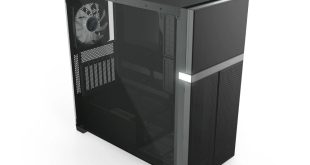Today Leo is back with another episode of Leo Says, with a big focus on the Intel XPU. A subject that has flown under the radar now for some time. What exactly is Intel's XPU all about ? Leo looks for answers.
Leo's Notes:
This past week I attended an Intel open house event at the Science Museum in London with Luke and we saw an array of 10th Gen Ice Lake laptops from Lenovo, Acer, Dell and MSI that will go on sale in the next month or so. We also sat through a number of keynote addresses and technical presentations and it was clear some of the slides we saw had previously appeared during the 2019 Intel Investor Meeting. During the day we asked a number of Intel people about the mysterious XPU and received blank looks in return. I guess the email has not yet arrived from the Intel Mothership.
Intel is going through strange and turbulent times, mainly because its 10nm process is a disaster zone but also because AMD has stepped up its game and is rewriting the rules for ‘How to build an x86 processor’
If your interest is PC gaming you may well look at the recent 10th Gen desktop announcements from Intel and wonder what the heck is going on.
Core i9-9900KS is a binned 9900K that is guaranteed to Turbo to 5.0GHz on all cores.
Core-X Cascade Lake X look like 9th Gen Skylake X parts with the price slashed in half and while that brings a clear benefit it is hardly exciting.
Heck, Intel’s 10nm process is so problematic that their 10th Gen mobile parts are a mix of 10nm+ Ice Lake and 14nm++ Comet Lake.
The technology behind Ice Lake looks interesting but the clock speeds are sorely disappointing and, what’s that, only quad core? Intel has been forced to use Comet Lake to deliver six cores with low power and decent clock speeds.
Compared to AMD’s Zen 2 the current state of Intel’s CPUs looks deeply unimpressive yet the fact is, Intel has continued to make serious money and is confident it will do well in the future, although 2019 is looking a bit shaky.
Part of the buzz is Internet of Things. IoT is going to be huge business globally, however it is not the least bit clear how much of the money will head Intel’s way.
What is clear is that the traditional PC is continuing to fade away. Intel will continue moving the technology forward with Ice Lake this year, then Lakefield and in 2020 we have promises of Tiger Lake with Xe graphics.
Intel Core i7-8809G Kaby Lake G with Vega graphics is now EOL.
Intel takes a massive percentage of the PC CPU TAM but has tiny shares of the Memory, Graphics and Connectivity markets.
To our eyes AMD is crushing the market with EPYC Rome and Ryzen 3000 while Intel has an olde worlde monolithic CPU design that still uses a 14nm process. On the other hand Intel owns the laptop market along with the vast majority of the server market and can boast about its Optane storage/memory products.
Say hello to Project Athena but take a closer look at Intel’s investments in graphics and what the heck is an XPU?
Navin Shenoy’s presentation is where we look for the first information to back up George Davis’ claims about future earnings.
For starters, 2020 looks shaky as Ice Lake samples are shipping to Xeon customers however 14nm Cooper Lake is also on the roadmap. Is there the slightest chance that Xeons will roll out at 10nm any time soon?
And then we move on to the good stuff – Intel is showing four different types of computing hardware.
Xeon GPU + Intel Xe GPU + Intel FPGA + Mobileye
and then we arrive at Dr. Murthy Renduchintala’s presentation and more talk about XPU and the move from PC-Centric to Data-Centric computing.
Intel paid US$16.7 billion for Altera
and another US$15.3 billion for Mobileye
https://www.kitguru.net/channel/generaltech/matthew-wilson/intel-is-buying-mobileyes-self-driving-car-firm-for-15-billion/Foveros technology is Intel’s method of combining chips that use different fabrication technology, such as Lakefield.
Intel is effectively writing off 10nm and 10nm+, but when it comes to 10nm++ in 2021 the planets start to align, and that is when Intel plans to debut their 7nm process.
The surprising thing is that Intel’s lead product with 7nm will be graphics, and not a regular CPU. Xe is headed for the data centre and AI where Intel will naturally have to compete with Nvidia.
Microsoft has announced its Surface Neo tablet using Lakefield, coming in Holiday 2020.
Right now we have no idea about 10th Gen 45W gaming laptop CPUs or the expected Comet Lake-S CPUs that will power 10th Gen gaming desktop PCs. It seems unlikely AMD will push into the laptop market any time soon so we have little choice but to wait and see what turns up at CES 2020.
KitGuru uses a variety of equipment to produce content: Panasonic GH5 and GH5s Cameras
Panasonic GH4 Cameras
Panasonic G7 Cameras
DJI OSMO Pocket Cameras
Canon Cameras
Various PC builds
Final output – colour grading/titling etc:
iMac Pro 18 Core/Vega 64/128GB
iMac 2019 9900k Vega 48/64/1TB
Adobe Premiere Pro CC (PC)
Davinci Resolve Studio 14/15 (Mac)
iPad Pro 12.9 inch (2018) machines with LumaFusion
Final Cut Pro (Mac)
KitGuru says: Be sure to let us know your thoughts and if you agree (or disagree) with LEO. Love him, or hate him- he says it, cause he means it!
 KitGuru KitGuru.net – Tech News | Hardware News | Hardware Reviews | IOS | Mobile | Gaming | Graphics Cards
KitGuru KitGuru.net – Tech News | Hardware News | Hardware Reviews | IOS | Mobile | Gaming | Graphics Cards


